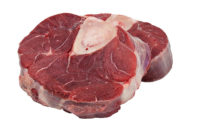Assessing outcomes of selection using genetic panels to predict marbling in crossbred beef cattle

Marbling, or intramuscular fat, in beef is a critical aspect of the consumer eating experience. Palatability — measured as tenderness, juiciness and flavor — improves with marbling increases. For this reason, the U.S. Department of Agriculture (USDA) Agriculture Marketing Service’s (AMS) Quality Grading System places emphasis on the amount of marbling when assigning carcasses a USDA quality grade. USDA quality grade ultimately plays a big part in determining the financial value of beef. Marbling deposition during an animal’s life is influenced by nutrition, management practices and the animal’s genetics.
Genetic tests have been commercially available to producers to test for marbling potential for the past couple of decades. In a study recently conducted by the meat science research team at the University of Idaho, it was concluded that genetic test scores for tenderness could be used to predict tenderness potential in beef cattle, which had been selected using their genetic panel scores for tenderness. There was still, however, a need to compare commercially available genetic test scores for marbling of crossbred cattle to their actual carcass marbling scores, mechanical tenderness in the form of Warner-Bratzler shear force (WBSF) and consumer sensory panel data. Therefore, our aim was to evaluate the effectiveness of genetic panel marbling index scores [Igenity (IT) and PredicGEN (PG)] to predict marbling and tenderness of crossbred beef cattle that have not been selected for any specific carcass quality traits.
To achieve our goal, blood samples from 23 steers were submitted to Neogen (IT) and Zoetis (PG) for genetic panel analysis. Marbling score and yield grade were determined according to USDA quality and yield grading standards one day after harvest. One boneless strip loin was collected from each carcass two days after harvest. On day four post-harvest, six steaks were cut from each strip loin and assigned to an aging period of 14 or 21 days and evaluated using a consumer sensory panel or WBSF analysis. Carcasses were grouped by their genetic panel index scores for marbling into Low IT (IT indexes 3-6; n = 16), High IT (IT indexes 7-10; n = 7), Low PG (PG index < 50; n = 9) or High PG (PG index > 50; n = 14). Steaks for all analyses were cooked to a target peak internal temperature of 160º F. The consumer sensory panel was conducted utilizing 92 consumer panelists.
Mean marbling score was observed to be greater in High IT steaks (small 96) than in Low IT steaks (small 10). Similarly, mean marbling score was observed to be greater in High PG steaks (small 58) than in Low PG steaks (slight 98). Tenderness measured by WBSF tended to be lower in High IT steaks than in Low IT steaks, but no difference was observed in tenderness between PG marbling groups. Consumers did not report differences between IT or PG marbling groups in terms of acceptability or tenderness. Regardless of IT or PG index, however, consumers consistently preferred Choice steaks over Select steaks in terms of overall acceptability and tenderness. Interestingly, yield grade was observed to be lower (i.e. the cutability of the carcass was greater) in the High IT and High PG groups.
Based on these results, commercially available genetic tests could be a valuable tool for producers to be able to predict marbling by retaining ownership of feedlot steers with high genetic panel indexes. At times when the Choice-Select spread is high ($20), genetic panels could be cost effective for feedlot managers to make feeding, implant and marketing decisions. Commercially available genetic panels, however, cannot replace nutrition and proper animal-handling practices which must continue to be maintained to the utmost standards to optimize the genetic potential of the fed cattle. Additional research needs to be done to conduct a more robust economic analysis on this data for determining how producers can benefit financially from using these tests in order to make better management decisions. Furthermore, additional research looking into the yield grade phenomenon observed in this study is needed to investigate whether the observation will hold true in a larger population of cattle.
If interested, the published manuscripts referenced in this article can be found at https://www.iastatedigitalpress.com/mmb/article/id/9549/ and https://academic.oup.com/tas/article/4/2/1238/5851500Looking for a reprint of this article?
From high-res PDFs to custom plaques, order your copy today!







